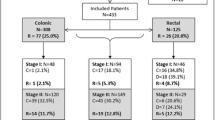Abstract
PURPOSE: Early detection of recurrence after curative resection for primary colorectal cancer should improve patients' prognosis. However, the usefulness of postoperative surveillance programs has not been clarified yet. The present cohort study was aimed at assessing the effectiveness of systematic follow-up in patients with colorectal cancer who were operated on for cure, regarding both rate of tumor recurrence amenable to curative-intent surgery and rate of survival. METHODS: One hundred ninety-nine colorectal cancer patients who underwent radical primary surgery were followed according a well-defined postoperative surveillance program, which consisted of laboratory studies (including serum carcinoembryonic antigen assay) every three months, physical examination and abdominal ultrasound or computed tomography every six months, and chest radiograph and total colonoscopy once per year. Cohorts were defined according to patients' compliance with the proposed follow-up program. A multivariate regression model was constructed to predict survival. RESULTS: One hundred forty patients were considered to be compliant with the surveillance program, whereas the remaining 59 patients occasionally attended follow-up investigations or did not comply at all. Although there were no differences in the overall recurrence rate (38vs. 41 percent;P=0.52), curative-intent reoperation was possible in 18 patients (34 percent) of those with tumor recurrence in the compliant cohort but in only 3 patients (12 percent) in the noncompliant cohort (P=0.05). Similarly, the probability of survival was higher in the compliant cohort, both regarding overall (63vs. 37 percent at 5 years;P<0.001) and cancer-related (69vs. 49 percent at 5 years;P<0.02) rates. Cox regression analysis disclosed that only a more advanced TNM stage (odds ratio, 8.17; 95 percent confidence interval, 1.13–59.29) and noncompliance with the postoperative surveillance program (odds ratio, 2.32; 95 percent confidence interval, 1.50–3.60) had an independent negative impact on survival. CONCLUSION: Systematic postoperative surveillance in patients with colorectal cancer who were operated on for cure increases both the rate of tumor recurrence amenable to curative-intent surgery and rate of survival.
Similar content being viewed by others
References
Boring CC, Squires TS, Tong T. Cancer statistics. CA Cancer J Clin 1993;43:7–26.
Safi F, Beyer HG. The value of follow-up of curative surgery of colorectal carcinoma. Cancer Detec Prev 1993;17:417–24.
Ovaska JT, Järvinen HJ, Mecklin JP. The value of a follow-up programme after radical surgery for colorectal carcinoma. Scand J Gastroenterol 1989;24:416–22.
Moertel CG, Fleming TR, Macdonald JS, Haller DG, Laurie JA, Tangen C. An evaluation of the carcinoembryonic antigen test for monitoring patients with resected colon cancer. JAMA 1993;270:943–7.
Kelly CJ, Daly JM. Colorectal cancer: principles of postoperative follow-up. Cancer 1992;70:1397–408.
Schiessel R, Wunderlich M, Herbst F. Local recurrence of colorectal cancer: effect of early detection and aggressive surgery. Br J Surg 1986;73:342–4.
Sugarbaker PH, Gianola FJ, Dwyer A, Neuman NR. A simplified plan for follow-up of patients with colon and rectal cancer supported by prospective studies of laboratory and radiologic test results. Surgery 1987;102:79–87.
Ovaska J, Järvinen H, Kujari H, Perttilä I, Mecklin JP. Follow-up of patients operated on for colorectal carcinoma. Am J Surg 1990;159:593–6.
Lautenbach E, Forde KA, Neugut AI. Benefits of colonoscopic surveillance after curative resection of colorectal cancer. Ann Surg 1994;220:206–11.
Eckardt VF, Stamm H, Kanzler G, Bernhard G. Improved survival after colorectal cancer in patients complying with a postoperative endoscopic surveillance program. Endoscopy 1994;26:523–7.
Bruinvels DJ, Stiggelbout AM, Kievit J, van Houwelingen HC, Habbema JD, van der Velde CJ. Follow-up of patients with colorectal cancer: a meta-analysis. Ann Surg 1994;219:174–82.
Vernava AM III, Longo WE, Virgo KS, Coplin MA, Wade TP, Johnson FE. Current follow-up strategies after resection of colon cancer: results of a survey of members of the American Society of Colon and Rectal Surgeons. Dis Colon Rectum 1994;37:573–83.
Richert-Boe KE. Heterogeneity of cancer surveillance practices among medical oncologists in Washington and Oregon. Cancer 1995;75:2605–12.
Beart RW Jr, Metzger PP, O'Connell MJ, Schutt AJ. Postoperative screening of patients with carcinoma of the colon. Dis Colon Rectum 1981;24:585–8.
Tornqvist A, Ekelund G, Leandoer L. The value of intensive follow-up after curative resection for colorectal carcinoma. Br J Surg 1982;69:725–8.
Makela JT, Laitinen SO, Kairaluoma MI. Five-year follow-up after after radical resection for colorectal cancer: results of a prospective, randomized trial. Arch Surg 1995;130:1062–7.
Safi F, Link KH, Beger HG. Is follow-up of colorectal cancer patients worthwhile? Dis Colon Rectum 1993;36:636–44.
Steele G. Standard postoperative monitoring of patients after primary resection of colon and rectum cancer. Cancer 1993;71:4225–35.
Virgo KS, Vernava AM, Longo WE, McKirgan LW, Johnson FE. Cost of patient follow-up after potentially curative colorectal cancer treatment. JAMA 1995;273:1837–41.
Kaplan GL, Meier P. Nonparametric estimation from incomplete observations. J Am Stat Assoc 1958;53:453–81.
Cox DR. Regression models and life tables. J R Stat Soc (B) 1972;34:187–220.
Wollmark N, Fisher ER, Wieand S, Fisher B. The relationship of depth of penetration and tumor size to the number of positive nodes in Dukes' C colorectal cancer. Cancer 1984;53:2707–11.
Sugarbaker PH, Zamcheck N, Moore FD. Assessment of serial carcinoembryonic antigen assays in postoperative detection of recurrent colorectal cancer. Cancer 1976;38:2310–5.
Ohlsson B, Breland U, Ekberg H, Graffner H, Tranberg KG. Follow-up after curative surgery for colorectal carcinoma: randomized comparison with no follow-up. Dis Colon Rectum 1995;38:619–26.
Markman M. CEA monitoring after primary therapy for colon cancer. J Cancer Res Clin Oncol 1995;121:385–6.
Ballantyne GH, Modlin IM. Postoperative follow-up for colorectal cancer: who are we kidding? J Clin Gastroenterol 1988;10:359–64.
Steele G. Follow-up plans after treatment of primary colon and rectum cancer. World J Surg 1991;15:583–8.
Author information
Authors and Affiliations
Additional information
Supported in part by grants from the Agència d'Avaluació de Tecnologia Mèdica de la Generalitat de Catalunya (2/6/96), the Fondo de Investigaciones Sanitarias de la Seguridad Social (96/0240), and the Marató TV3-Càncer (95/3008).
About this article
Cite this article
Castells, A., Bessa, X., Daniels, M. et al. Value of postoperative surveillance after radical surgery for colorectal cancer. Dis Colon Rectum 41, 714–723 (1998). https://doi.org/10.1007/BF02236257
Issue Date:
DOI: https://doi.org/10.1007/BF02236257




